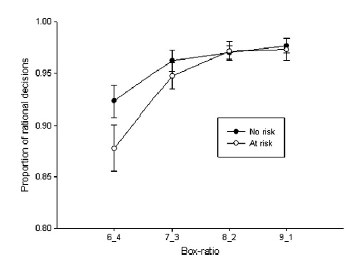Researchers are investigating the neurological factors that might play a role in the development of pathological gambling. For example, cognitive deficits, such as dementia and reduced executive functioning are well-known correlates of pathological gambling (PG; Manes, Torralva, Roca, Gleichgerrcht, Bekinschtein, & Hodges, 2011). Grant and colleagues suggested that cognitive deficits create risk because they lead to impaired decision-making, which in turn leads to PG (Grant, Brewer, & Potenza, 2006). Today’s WAGER reviews a study that explores whether young adults with decision-making impairments are also more likely to be at-risk for the development of PG (Grant, Chamberlain, Schreiber, Odlaug, & Kim, 2011).
Methods
- One hundred eighty-six participants who responded to media advertisements met criteria (i.e., 18-29 year olds who gambled at least 5 times during the past year, but did not meet criteria for PG) for the study.
- One hundred and twelve did not affirm any DSM-IV-TR criteria for PG (i.e., low-risk) and 74 participants met one or two criteria for PG (i.e., at-risk). Researchers excluded participants meeting three or more PG criteria.
- Researchers administered of tests to assess PG and decision-making impairments.
- Of specific relevance to this summary, the Cambridge Gamble Task (CGT) is a computerized measure that assesses participant’s rational decision-making abilities in an ambiguous gambling scenario (Grant, et al., 2011).
- The program presents a series of 10 red or blue boxes to the participants, along with instructions that one box contains a ‘token’.
- The ratio of red to blue boxes changes with each trial. This box-ratio varies from 10:0 to 6:4, with each condition introducing more ambiguity.
- Participants choose whether the token is in a red or blue box. A ‘rational decision’ is choosing the color with the majority of boxes (e.g., choosing red when there are seven red and three blue boxes).
- The program initially assigns participants 100 points; each round, participants bet a proportion of their points.
- Of specific relevance to this summary, the Cambridge Gamble Task (CGT) is a computerized measure that assesses participant’s rational decision-making abilities in an ambiguous gambling scenario (Grant, et al., 2011).
Results
- There was a significant effect of box-ratio (F = 27.80, p < .001) and a significant group x box-ratio interaction (F = 3.63, p = .013).
- All participants made fewer rational decisions as the box-ratio decreased. This tendency was more pronounced among the at-risk group than the low-risk group (see Figure 1).
- The at-risk group also wagered a significantly greater number of points regardless of box-ratio (F = 7.34, p < .01).
Figure 1: Proportion of rational decisions for each box-ratio (From Grant, et al., 2011, reprinted with permission).
Limitations
- These data cannot determine causality. In other words, we cannot conclude whether participants are at-risk because of decision-making deficits, or whether another factor causes both.
- The current study does not determine whether the at-risk participants eventually develop PG. A longitudinal extension to this study is in progress, however, and will remediate this issue.
- The CGT only assesses a specific area of cognition. There are many other tests that assess other aspects of cognition and decision-making.
Conclusions
This study shows that at-risk young adult gamblers tend to have impaired decision-making, as assessed by ratio of rational decisions on the CGT. This study is particularly interesting as it is the first to explore cognitive impairment as a PG risk factor among at-risk, but otherwise healthy gamblers. Previous studies have examined cognitive impairment among participants who already had a diagnosis of PG. Although further study is necessary to establish a causal linkage between impaired decision-making and PG, this study provides a starting point for additional studies that might provide important insights into the etiology and underlying mechanisms of PG. Such research may eventually lead to advances in the detection, prevention and treatment of pathological gambling.
-Daniel Tao
What do you think? Please use the comment link below to provide feedback on this article.
References
Grant, J.E., Brewer, J.A., Potenza, M.N. (2006). The neurobiology of substance and behavioral addictions. CNS Spectrums, 11, 924–930.
Grant, J.E., Chamberlain, S.R., Schreiber, L.R., Odlaug, B.L., Kim, S.W. (2011). Selective decision-making deficits in at-risk gamblers. Psychiatry Research, 189, 115-120.
Mares, F.F., Torralva, T., Roca, M., Gleichgerrcht, E., Bekinschtein, T.A., Hodges, J.R. (2011). Frontotemporal dementia presenting as pathological gambling. Nature Reviews Neurology, 6, 347-352.
Welte, J.W., Barnes, G.M., Wieczorek, W.F., Tidwell, M-C.O., Parker, J.C. (2004). Risk factors for pathological gambling. Addictive Behaviors, 29(2), 232-335.






Elizabeth George September 15, 2011
Excellent information and research. I would very much like to forward this link to an email list of interested individuals. Do I need your permission? I will of course cite your work.
The BASIS Staff September 29, 2011
Dear Elizabeth,
Please feel free to provide this link to interested individuals. You can also share this article using Facebook and Twitter. You can also share the link for our mailing list – http://www.basisonline.org/subscribe.html.
Best,
The BASIS Staff